Esports Origin Stories: The Birth and Rise of Competitive Gaming
Updated On: November 13, 2025 by Aaron Connolly
Defining Esports and Competitive Gaming
Esports means organised video game competitions where players or teams battle for prizes, recognition, and sometimes even a career. The esports industry covers everything from small local tournaments to massive global events worth millions.
What really stands out about competitive gaming is its digital heart, wide range of game genres, and how quickly it’s grown from old-school arcades to a billion-pound business with pro leagues and streaming giants.
What Sets Esports Apart from Traditional Sports
Esports and traditional sports? Not quite the same thing. The most obvious difference—everything happens on a screen, not a field.
Instead of a single sport, esports covers loads of games. Each one has its own rules, team sizes, and required skills. League of Legends has five-player teams and demands strategy. Counter-Strike is all about quick reflexes and pinpoint aim.
Game developers keep things fresh with regular updates. New patches can add characters, tweak maps, or shift strategies overnight.
| Traditional Sports | Esports |
|---|---|
| Physical skill primary | Mental skill and reflexes |
| Stable rules | Regular updates |
| Geographic limitations | Global online competition |
| Seasonal schedules | Year-round tournaments |
It’s also more accessible. If you have a gaming device and an internet connection, you can jump in. Forget expensive gear or club fees—almost anyone can give it a shot.
Popular Esports Genres and Formats
Esports games fall into a few main categories, each with its own style. MOBAs like League of Legends and Dota 2 put two teams against each other, trying to destroy the enemy base.
First-person shooters focus on tactical gunfights. In games like Counter-Strike and Valorant, teams plant or defuse bombs while trying to outshoot the other side.
Battle royales like Fortnite throw 100 players onto a shrinking map. Only one team or player survives.
Fighting games—think Street Fighter or Tekken—are all about one-on-one battles. Timing and combos matter most.
Real-time strategy games such as StarCraft II push players to manage resources and armies, outsmarting their opponents.
Sports simulations like FIFA and Rocket League take classic sports and add a digital spin. Rocket League, for example, is soccer with rocket-powered cars.
Tournaments come in different shapes. Some use single elimination brackets, while others start with round-robin groups and move to playoffs.
Evolution of the Esports Industry
The esports industry started as a handful of university experiments and grew into a full-blown entertainment business. In 1972, Stanford University hosted the first known tournament for Spacewar! They gave the winner a Rolling Stone subscription—hardly a fortune, but it mattered.
By the 1980s, arcade competitions were everywhere. The 1980 Space Invaders tournament brought in around 10,000 players from across the US.
The 1990s changed everything with online multiplayer. Suddenly, players could compete worldwide without leaving home. The word “esports” didn’t really exist until 2000, but communities had already started forming.
Streaming in the 2010s made esports explode. Platforms like Twitch and YouTube Gaming let millions tune in, and prize money jumped from thousands to millions.
Quick win: Check out highlights from The International (Dota 2) or League of Legends Worlds to get a sense of the scale.
Today, esports features:
- Professional teams that pay salaries and hire coaches
- Dedicated venues built just for gaming events
- Broadcast deals with big sports networks
- University scholarships for top players
- Government recognition as a real sport in some countries
Money comes in from sponsorships, media rights, merch, and ticket sales—just like traditional sports.
The Earliest Seeds: Pre-Esports Competitive Play
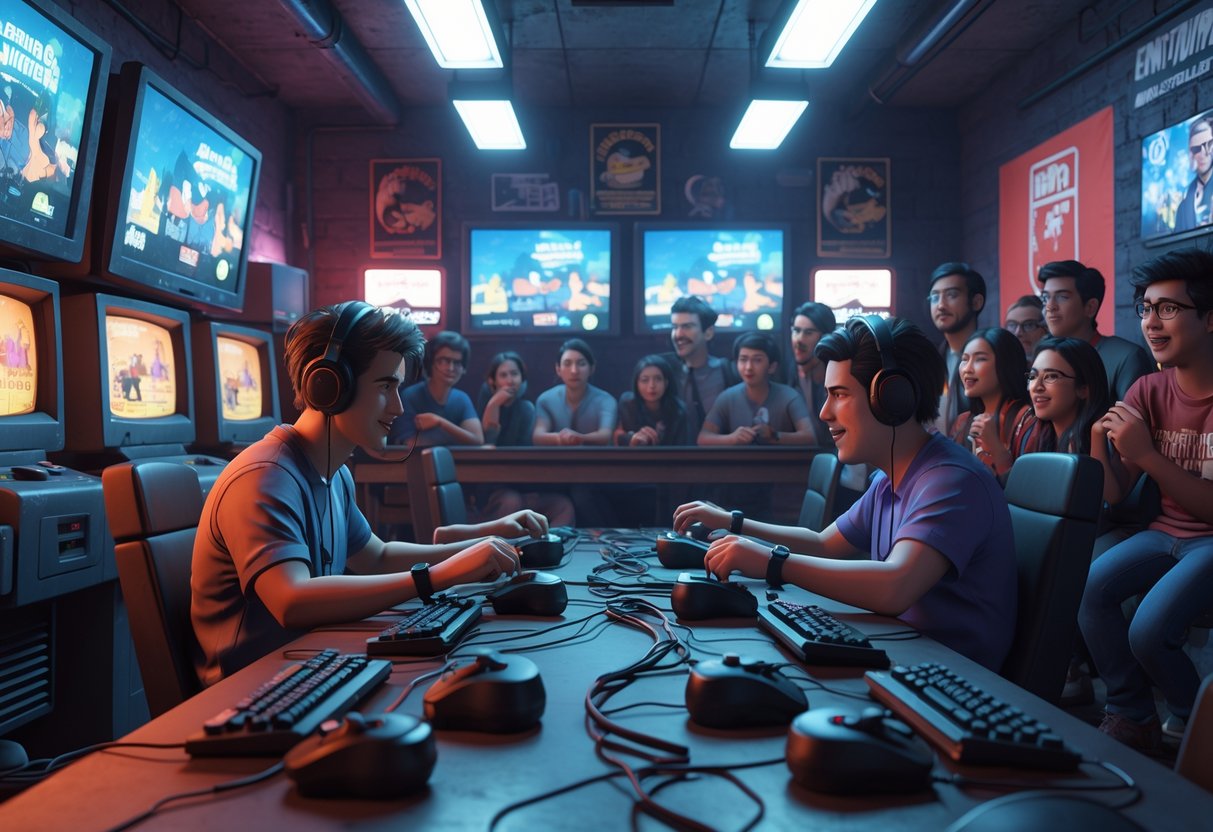
Before tournaments or pro leagues, early video games sparked the competitive bug. Simple two-player games and arcade high scores gave people their first taste of digital rivalry.
Tennis for Two and Pong: Dual Player Pioneers
Tennis for Two came along in 1958, letting two people face off head-to-head. William Higinbotham built it at Brookhaven National Lab, and the game ran on an oscilloscope.
Players twisted knobs to knock a ball back and forth. Crowds lined up at open houses just to play.
Pong hit arcades in 1972 and brought competitive gaming to the mainstream. Atari rolled out a simple game: two paddles, a bouncing square ball.
Pong made competition instant and easy. No need for long rules or tutorials. Two people could start playing right away.
People loved it. Pong cabinets popped up in bars, bowling alleys, and diners all over.
Arcade Games and the Competitive Spirit
Arcade games in the late ’70s and early ’80s turned casual play into serious competition. Space Invaders, Pac-Man, and Donkey Kong all sparked rivalries.
Arcades became hangouts for ambitious players. People crowded around top competitors, picking up tips and watching their moves.
Every quarter counted. Players wanted to last longer and rack up higher scores to get the most from their money.
Atari’s 1980 Space Invaders Championship drew over 10,000 players across the US. It showed there was real hunger for organised video game competition.
Local arcades built their own mini-communities. Everyone knew who held the top scores. Beating the local champ? That was a big deal.
Introduction of High Score Lists
High score lists changed the game. Suddenly, achievements stuck around for everyone to see.
Early machines showed three-letter initials next to scores. These leaderboards started fierce rivalries. Players came back day after day to defend their spot.
Twin Galaxies showed up in 1981 as the official scorekeeper. Walter Day founded it, tracking records from all over.
They set rules for how to verify scores. That gave competitive gaming an official, structured feel.
Chasing high scores pushed players to invent new tricks and sharpen their skills. Some people spent hours practicing, just like athletes do.
These early systems set the stage for the ranking and leaderboard systems esports uses today.
Academic Milestones in Esports Origins

Universities played a big part in launching the first organised video game competitions. Stanford University hosted the first recorded gaming tournament in 1972. MIT, on the other hand, pushed technical innovation that shaped competitive gaming.
Stanford University and the Intergalactic Spacewar Olympics
Stanford made esports history in October 1972. Students met up to compete in Spacewar!, a space combat game popular on college computers.
They called the event the Intergalactic Spacewar Olympics—pretty bold, right? This was the first known organised video game tournament.
The winner got a year’s subscription to Rolling Stone. Not a huge prize, but it was real recognition for gaming skill.
The tournament brought people together. Students set rules and kept records.
This event proved video games could be more than just a way to pass time. Today’s massive esports events all trace back to this single college meetup.
Other universities took notice and started running their own competitions. Colleges became early test labs for competitive gaming.
MIT’s Role in Video Game Innovation
MIT helped esports grow through technical breakthroughs, not just tournaments. Students and researchers there created some of the first multiplayer games.
MIT’s computer labs gave students access to hardware most folks couldn’t dream of owning.
Some MIT grads went on to start game companies and build commercial hits. Their academic work became the foundation for the gaming industry.
The university’s culture encouraged experimentation. Students kept pushing the limits, inventing new game designs and competitive formats.
Without MIT’s early work in computing and game development, it’s hard to imagine what esports would look like today.
Arcades and the Birth of Mass Tournaments
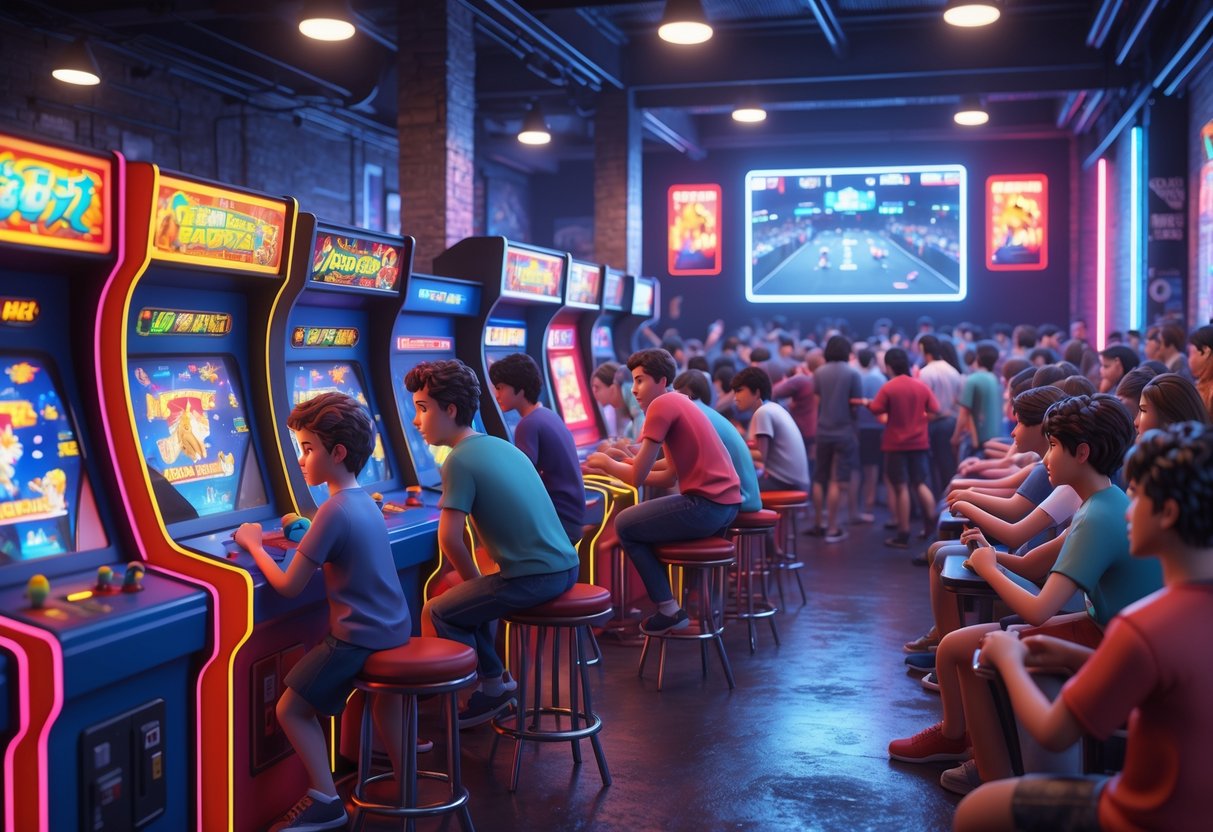
By the late 1970s, arcades took competitive gaming to the next level. Local high-score battles turned into mass tournaments. Atari’s Space Invaders championships drew thousands, while Japanese arcades built competition formats that still influence esports.
Space Invaders Championships and Atari’s Influence
Atari really shook things up in 1980 with the National Space Invaders Championship. Over 10,000 players across the US went for the top spot.
The rules were simple. Each player got one shot to post their highest score. Local winners moved to regionals, then to the national finals.
Crowds packed arcades, hoping to watch or win. The prize? An Atari console and some games—not huge, but the bragging rights were massive.
Winners became local legends. This event set the template: qualifiers, regionals, and a big grand final.
Atari’s success inspired more tournaments for games like Pac-Man, Donkey Kong, and Centipede. Arcades became early esports arenas, with fans cheering for their favorites.
Japanese Arcades and Sega’s Early Competitions
Meanwhile, Japan built its own competitive gaming culture. Sega led the way, setting up structured tournaments in their arcades.
Japanese arcades introduced league systems. Players earned points over many sessions, so consistent performance really mattered.
Sega’s fighting game tournaments became legendary. Games like Virtua Fighter attracted serious players who studied every detail and crafted deep strategies.
The Japanese approach felt different. Atari liked single-elimination events, but Sega built ongoing seasons. Players faced regular opponents and developed long-term rivalries.
Players started traveling between arcades, building communities that looked a lot like today’s esports teams. The social side became just as important as the competition.
Japanese tournaments introduced bracket systems, ranking ladders, and formats that made spectating more exciting. A lot of what we see in modern esports started here.
Pioneering Esports Tournaments of the 1980s
By the 1980s, competitive gaming moved out of college labs and into arcades and living rooms across the UK and US. Major tournaments like the National Space Invaders Championship drew thousands, and organisations like Twin Galaxies started tracking official high scores that gamers still chase today.
National Competitions and High Score Battles
The 1980 National Space Invaders Championship really changed the game for competitive gaming. Over 10,000 players showed up across America, and the final showdown happened in New York City.
This wasn’t just some small group of fans hanging out. The tournament pulled in mainstream media and proved competitive gaming could attract huge crowds.
William Salvador Heineman took home the championship on October 10, 1980. He became the first officially recognised winner of a national video game tournament.
Key 1980s tournaments included:
- Space Invaders Championships (1980-1982)
- Pac-Man competitions in arcades nationwide
- Local Iron Man challenges (endurance gaming)
Organisers usually set up arcade cabinets in shopping centres or gaming venues. Players chased high scores instead of battling each other directly.
The format kept things simple. Each player had a set time or lives to rack up the biggest score.
Twin Galaxies and Official Scorekeeping
Walter Day started Twin Galaxies in 1981 in Ottumwa, Iowa. His group became the first to officially track video game world records.
Before Twin Galaxies, nobody really kept a standard record of gaming achievements. Anyone could claim a high score, and there wasn’t much proof.
Day and his team set up strict rules for submitting scores. They asked for witnesses, photos, and sometimes even video to confirm record attempts.
Twin Galaxies’ verification process:
- Witnessed gameplay sessions
- Photographic evidence of final scores
- Detailed documentation of game settings
- Official referee oversight for major attempts
They tracked scores for dozens of popular arcade games. Gamers everywhere finally had official leaderboards to chase.
Twin Galaxies also organised tournaments and brought together competitive players from different regions. Their monthly newsletter spread news about new records and upcoming competitions.
Televised Gaming Events
Television coverage brought competitive gaming into British and American living rooms by the mid-1980s. Shows like “Starcade” in America let contestants face off in arcade games for prizes.
These programmes actually treated gaming competitions with respect. They used professional cameras and experienced hosts to cover the action.
Popular gaming TV formats included:
- Tournament-style competitions with eliminations
- Head-to-head challenges between skilled players
- Celebrity gaming specials with familiar faces
Production values matched other sports shows of the time. Cameras zoomed in on joystick movements and screen action.
These shows introduced millions to the idea of competitive gaming. For many, it was the first time seeing skilled players and learning about gaming strategies.
Television brought in sponsors and advertisers. That early commercial interest helped lay the groundwork for today’s esports business model.
Gaming programmes usually aired in the afternoons or on weekends. They aimed at younger viewers but often pulled in whole families.
Console and Home Gaming’s Expansion

Home consoles changed competitive gaming forever. Suddenly, you didn’t need to go to an arcade—competitions could happen right at home.
Nintendo led this shift with the Nintendo World Championships in 1990, and other console makers started building their own communities around competitive play.
Nintendo World Championships and Home Console Events
The Nintendo World Championships in 1990 was the first big competitive gaming event made just for home consoles. Nintendo ran this massive tournament across 30 US cities to promote their games and systems.
Players competed on a custom cartridge with Super Mario Bros., Rad Racer, and Tetris. The idea was simple: get the highest score in six minutes.
Over 100,000 people joined in. Winners got prizes like savings bonds and gaming systems. This event really showed that console gaming could pull in big competitive crowds.
Nintendo took a different approach than arcade tournaments. They focused on family-friendly competition, not just hardcore gamers.
That strategy helped make competitive gaming feel more mainstream. It wasn’t just for the die-hards anymore.
The original championship cartridges turned into collector’s items. Grey cartridges from the tour now sell for thousands of pounds.
The Growth of Competitive Console Gaming
Console gaming didn’t just stop at big events. It sparked ongoing communities.
When Nintendo launched the NES in 1985, millions of homes started gaming worldwide. That changed everything.
Home consoles had clear advantages over arcades. Players could practise as much as they wanted without dropping coins. Skills improved, and competition got tougher.
Game shops and community centres started running local tournaments. Consoles made it easier—no need for expensive arcade cabinets.
Other companies saw the trend and jumped in. Sega ran competitions for Sonic the Hedgehog. Console makers realised tournaments boosted both game sales and brand loyalty.
Fighting games like Street Fighter II on consoles kicked off their own competitive scenes. Players could master complex moves at home before showing up to compete.
The Internet Age: Online Play and Global Communities

The internet’s arrival in the 1990s took competitive gaming global. Broadband let players face off with opponents thousands of miles away, and streaming platforms eventually brought these matches to massive audiences.
Impact of the Internet on Esports
The internet totally changed how we compete and watch games. Before broadband connections became common, you could only play against people nearby at arcades or gaming centres.
Online multiplayer games like Counter-Strike, Quake III Arena, and StarCraft popped up in the late 1990s. Suddenly, players could connect from home and compete with anyone around the world.
This shift created the first real esports communities. Developers noticed the potential and jumped in.
Companies like Blizzard and Valve started running official tournaments for their games. Prize pools grew from magazine subscriptions to thousands of pounds.
Key games that drove early online competition:
- Counter-Strike (1999): Team-based tactical shooter
- StarCraft (1998): Real-time strategy with tight controls
- Quake III Arena (1999): Fast-paced arena shooter
Streaming platforms like Justin.tv (which became Twitch) launched in the mid-2000s. Now, anyone could broadcast their gameplay live.
Fans could watch their favourite players practise and compete from anywhere.
LAN Parties and Early Online Tournaments
LAN parties bridged the gap between arcade gaming and today’s online esports. Players met up in person but used local networks for competition.
Major LAN events like DreamHack (started 1994) and QuakeCon (started 1996) brought in hundreds of players. Everyone lugged in their own computers and played over local networks.
That created a wild atmosphere you just couldn’t get online.
Early online tournaments had technical headaches. Internet connections weren’t always reliable, so many events used hybrid formats—online qualifiers, then in-person finals.
The Cyberathlete Professional League (CPL) launched in 1997 and became one of the first big tournament organisers. They offered prize pools up to $100,000 and helped make esports a real competitive scene.
People started travelling internationally just to compete in video games. Spectators loved watching skilled players go head-to-head, setting the stage for today’s massive esports audiences.
The Evolution of Esports Titles
Esports evolved from simple arcade shooters to complex strategy games. Three big shifts pushed things forward: tactical shooters, real-time strategy in Korea, and new console esports with team-based arena games.
Transition from Doom and Quake to Counter-Strike
Doom and Quake set the stage for competitive first-person shooters in the 1990s. They brought in fast-paced action and multiplayer tournaments.
Doom had basic deathmatch modes. Players fought in simple arenas with not much room for tactics.
Quake stepped it up with better netcode and more precise movement. Serious competitors mastered rocket jumping and weapon timing.
Counter-Strike changed everything when it launched as a Half-Life mod in 1999.
The game introduced:
- Round-based gameplay instead of constant respawning
- Economy system for buying weapons and gear
- Objective-based maps demanding team coordination
- Role specialisation between terrorists and counter-terrorists
Counter-Strike demanded communication and strategy over pure reflexes. Teams had to plan rushes, set up defences, and manage their money.
This shift from solo skill to team tactics built the foundation for modern esports. Professional teams started forming, each with leaders, support players, and standout fraggers.
StarCraft’s Impact and Korean Esports
StarCraft made South Korea the first true esports powerhouse when it launched in 1998. Timing and culture played huge roles.
South Korea had great internet and a culture that embraced gaming. PC bangs (internet cafés) became training grounds for future pros.
StarCraft’s depth drew in serious competition:
- Three unique races with different strategies
- Resource management that forced constant decisions
- Micro and macro skills testing both precision and planning
- Build order variety that kept matches unpredictable
Korean TV started broadcasting StarCraft matches on gaming channels. Pro players became celebrities with fan clubs and sponsors.
The Korean model proved esports could support pro leagues, dedicated venues, and full-time players. Big teams like SK Telecom T1 invested in coaching and player development.
StarCraft’s influence spread worldwide through international tournaments and online streams. The game showed that strategic depth could be just as entertaining to watch as it was to play.
Emergence of Halo and Early MOBAs
Halo put competitive gaming on consoles with its 2001 Xbox launch. The game showed esports didn’t have to be PC-only.
Halo’s design made competition natural:
- Equal starts—everyone spawned with the same gear
- Map control through power weapon and power-up spawns
- Skill-based mechanics like precise aiming and movement
- Team objectives in modes like Capture the Flag
Major League Gaming (MLG) picked up Halo as a flagship console title. Players who didn’t have gaming PCs could finally compete.
Early MOBA games grew out of real-time strategy. Defence of the Ancients (DotA) started as a Warcraft III mod in 2003.
MOBAs introduced big changes:
| Element | Traditional RTS | MOBA Innovation |
|---|---|---|
| Control | Multiple units | Single hero character |
| Progression | Match resets | Levelling within matches |
| Team Size | 1v1 focus | 5v5 coordination |
| Objectives | Base destruction | Multi-layered goals |
Early MOBAs demanded teamwork and individual skill. Players had to master specific heroes and work together for objectives.
The mix of easy entry and deep strategy made MOBAs explode in popularity. That led to today’s giants like League of Legends and Dota 2.
Defining Modern Esports: Major Leagues and Spectacle
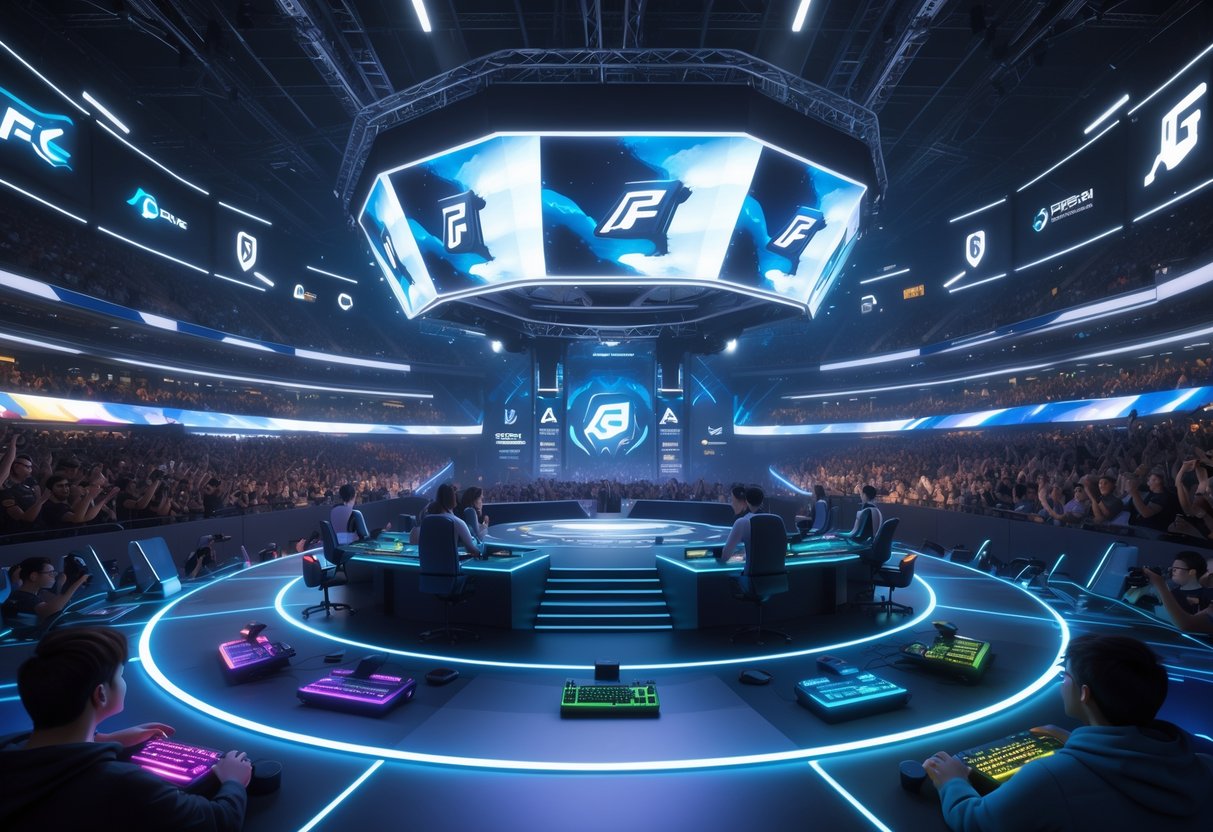
Esports went from casual tournaments to professional leagues thanks to groundbreaking competitions. Events like Red Annihilation, the rise of MOBA games like Dota 2 and League of Legends, and international showdowns such as the Electronic Sports World Cup all helped build today’s multi-million pound industry.
Red Annihilation’s Influence on Competitive Play
Red Annihilation changed everything when John Carmack put his Ferrari 328 up as the grand prize for the 1997 Quake tournament. This wasn’t just another gaming event—it was the first time a prize of that value pulled in serious competitors.
Over 2,000 players joined online. Dennis “Thresh” Fong took the win and drove away with the Ferrari, showing that competitive gaming could reward players in a big way.
Red Annihilation set a bunch of standards for modern esports:
- High-stakes prizes that made professional training worth it
- Elimination brackets now used in most major tournaments
- Live audience engagement both online and in-person
- Media coverage that reached beyond gaming magazines
Developers started building competitive features right into their games. We started seeing spectator modes, ranking systems, and tournament tools that made organising big events possible.
The Rise of Dota 2 and League of Legends
League of Legends and Dota 2 totally changed esports. These games mixed deep strategy with action that millions could actually follow.
People could tune in and understand what was happening, even if the games looked complex at first. MOBA games showed that you can have depth without confusing everyone.
Riot Games kicked off the League Championship Series (LCS) in 2013. They offered guaranteed salaries, which was a game-changer.
This franchise model gave players real stability. Instead of scrambling for the next event, they could just focus on getting better.
Key features that defined modern esports:
| Element | Impact |
|---|---|
| Regular seasons | Consistent viewing schedules like traditional sports |
| Franchised teams | Long-term investment from sponsors and cities |
| Broadcasting production | Professional commentary and analysis |
| Prize pools | Multi-million pound tournaments drawing global attention |
Dota 2’s The International changed how prize pools worked by bringing in crowdfunding.
In 2021, fans pushed the prize pool to $40 million. Lately, things have calmed down, with more modest pools around $2.8 million as the scene finds its footing.
League of Legends pulls in a staggering 89.9 million hours of Twitch viewership. It sits comfortably as the most-watched esports title on the planet.
Electronic Sports World Cup and International Competitions
The Electronic Sports World Cup (ESWC) set the blueprint for global esports events as we know them.
Back in 2003, ESWC brought players from all over the world together. They competed in different games under one big, flashy banner.
ESWC rolled out a few ideas that everyone uses now:
- Multi-game format so lots of communities could join in
- National representation—kind of like the Olympics, but for gaming
- Standardised rules across all regions
- Professional broadcast production with live commentary
This tournament’s influence went further than just the games. It inspired groups like the International Esports Federation (IESF) and the Esports Integrity Commission (ESIC), both of which now keep things fair at big events.
Modern international competitions now look a bit different:
- City-based teams—think Overwatch League’s franchise approach
- Regional qualifiers for world championships
- Broadcast partnerships with ESPN, BBC, Sky Sports
- Corporate sponsorship from big brands like Coca-Cola and Coinbase
These events showed the world that esports could pack arenas and get mainstream attention. Competitive gaming finally got treated like real sport entertainment.
Esports Enters the Mainstream
Esports didn’t stay a niche hobby for long. Through strategic partnerships, pro leagues, and streaming, it exploded into a billion-pound industry.
Streaming tech and big-money sponsors made competitive gaming something you could actually watch, not just play.
The Role of Twitch in Popularising Esports
Twitch changed the way we watch competitive gaming. When it launched in 2011, you could suddenly watch live tournaments and player streams from anywhere.
Twitch chat made it all feel like a shared event. Fans could shout and celebrate wild moments together.
Major tournaments just kept getting bigger:
- League of Legends World Championship 2012: 8 million viewers
- 2019 World Championship: Over 100 million viewers
- Fortnite World Cup 2019: 2.3 million concurrent Twitch viewers
Twitch made esports available around the clock. No need to wait for TV schedules anymore.
Players streamed their practice sessions, letting fans peek behind the curtain. That kind of access made the whole thing feel personal.
Twitch’s subscription model changed the business side, too. Fans could support their favourite players and teams directly, which helped esports grow even more.
Franchised Leagues and Professionalisation
Around 2016, esports started borrowing from traditional sports. Overwatch League brought in city-based teams and real salaries, which caught the eye of serious investors.
Key franchise developments:
- Overwatch League: $20 million franchise fees, minimum £38,000 player salaries
- League of Legends Championship Series: Permanent partnership spots, revenue sharing
- Call of Duty League: Geographic franchises, £19 million entry fees
These leagues brought a kind of stability that esports just didn’t have before. Players landed contracts, health benefits, even retirement plans.
Teams invested in coaches, analysts, and training facilities. The whole scene levelled up.
Big sponsors like Mercedes-Benz, Mastercard, and Coca-Cola jumped in. Traditional broadcasters such as BBC and Sky Sports started showing tournaments.
Suddenly, business journalists were tracking team valuations and player trades. Esports got treated like a “real” sport.
Esports as Mass Entertainment
By 2018, major broadcasters finally noticed the entertainment power of esports. ESPN started airing tournaments and talk shows about competitive gaming.
Viewership matched or beat traditional sports:
| Event | Peak Viewers | Comparison |
|---|---|---|
| LoL Worlds 2022 | 74.6 million | Exceeds NBA Finals average |
| The International 2022 | 2.7 million | Rivals Premier League matches |
| CS Major 2022 | 2.7 million | Matches top tennis tournaments |
Celebrities and athletes wanted in. Drake bought a piece of 100 Thieves. David Beckham invested in Guild Esports.
Prize pools reached jaw-dropping heights. The International Dota 2 tournament regularly tops £30 million.
Physical venues started hosting esports, too. The O2 Arena in London held League of Legends finals. New esports arenas popped up in major cities.
Gaming companies started working with entertainment giants. Netflix made esports documentaries. Musicians performed at tournament openings, turning them into real events.
Key Figures and Organisations in Early Esports
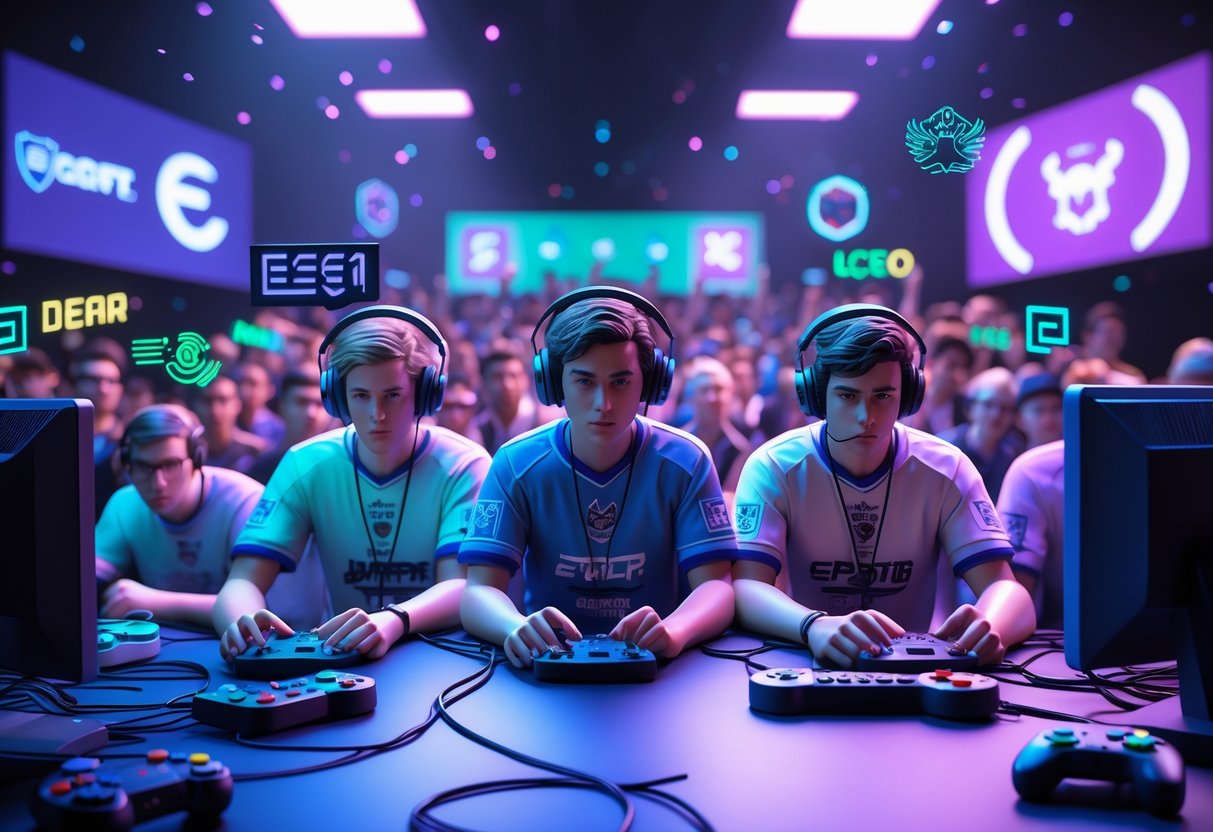
Two people really shaped early esports into something organised. Walter Day launched Twin Galaxies in 1981 to track arcade scores. Angel Munoz started the Cyberathlete Professional League (CPL) in 1997 and set up the first proper PC gaming tournaments.
Walter Day and the Creation of Twin Galaxies
Walter Day opened his arcade in Ottumwa, Iowa, back in 1981. He saw players arguing about who actually had the best Pac-Man or Donkey Kong scores.
Day decided to fix that. He travelled across the country, visiting arcades and recording the top scores.
That effort became the first official video game scoreboard.
Twin Galaxies became the go-to place for arcade records. Day set strict rules: players had to submit video evidence or play in front of witnesses.
The organisation made headlines when it verified Billy Mitchell’s perfect Pac-Man score in 1999.
Twin Galaxies tracked high scores for classics like Donkey Kong and Galaga.
Day’s work proved that video games could have official records and tournaments, just like sports.
Founding of the Cyberathlete Professional League
Angel Munoz launched the Cyberathlete Professional League (CPL) in 1997.
This was one of the first groups to organise professional PC gaming tournaments with real prize money.
CPL focused on first-person shooters like Quake and Counter-Strike. Munoz set up tournaments where top players could win up to $100,000.
These events drew crowds—hundreds of players and thousands of fans. The CPL proved people would pay to watch competitive gaming.
Big sponsors like Intel and AMD got involved.
The league ran until 2008 but set the standard for future tournaments. They introduced proper tournament formats, anti-cheating rules, and professional broadcasts.
Plenty of today’s esports organisations borrowed CPL’s ideas.
Munoz showed esports could be a real business. His tournaments highlighted the commercial potential that would eventually lead to the industry we see now.
Reflecting on Esports History and Future Directions
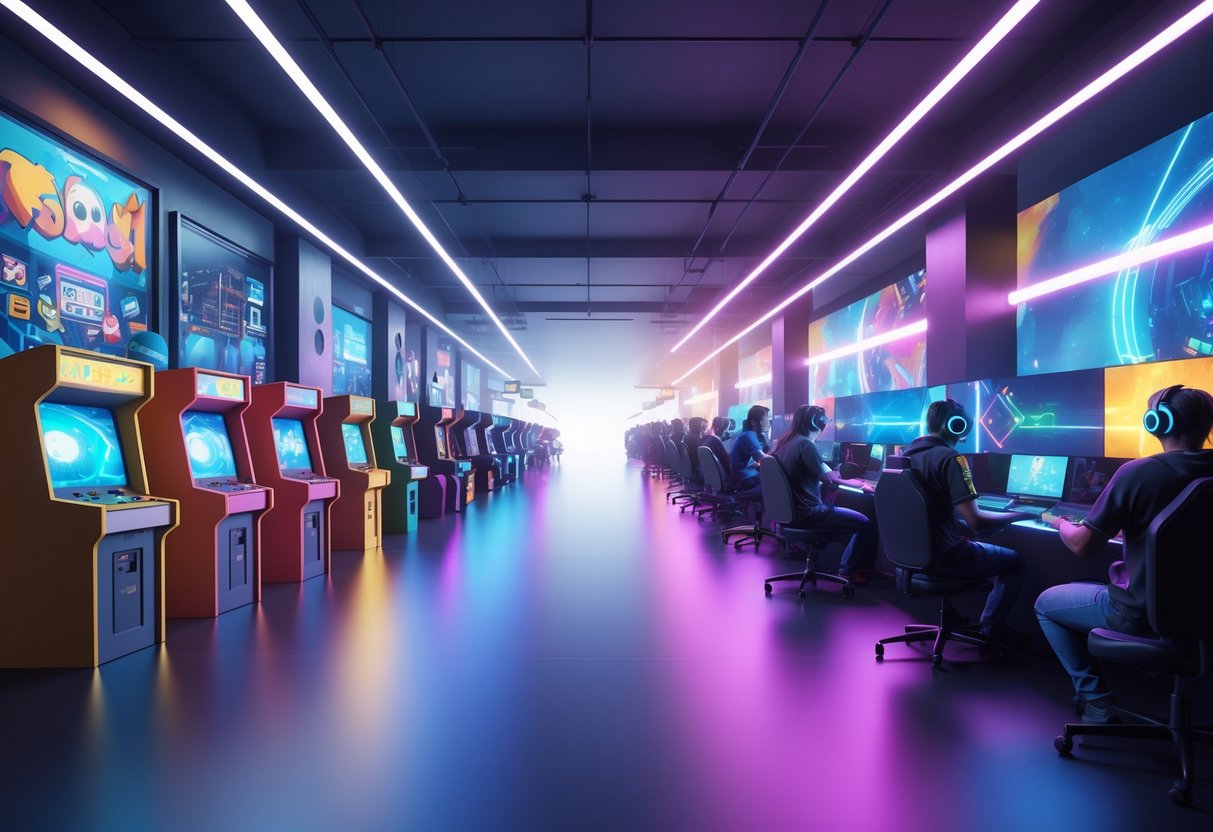
The story of esports shows just how fast digital competition can grow. We’ve gone from university experiments to a global entertainment industry.
With mobile gaming, VR, and streaming tech, even more people can join in. New formats and experiences are popping up all the time.
Lessons from Esports History
Esports began in 1972 at Stanford with a Spacewar tournament. That event proved people will compete wherever there’s a skill gap.
Back then, 10,000 players battled for a Rolling Stone subscription. Now, the industry is worth $1.6 billion.
Grassroots communities powered early esports. Counter-Strike and Unreal Tournament built loyal followings before big leagues got involved.
This still happens today as new games find their own fans.
A few key patterns stand out:
- Community-first growth – The best esports titles build passionate player bases before leagues show up
- Technology drives change – Online play, streaming, and better internet each sparked growth
- Mainstream follows money – Broadcasters like ESPN and BBC joined in once the audience and sponsorships were there
From 2020 to 2023, growth slowed a bit. Prize pools at Dota 2’s The International dropped from £32 million to £2.2 million.
This shows that keeping communities engaged matters more than just throwing money at the problem.
Regulation became a big deal as cheating and match-fixing threatened the scene. Groups like the Esports Integrity Commission now work to keep things fair.
Ongoing Innovations and Prospects
Mobile esports might be the next big thing. Phone-optimised games reach people who don’t have gaming PCs.
In Asia, mobile dominates. In North America, consoles still have a big presence.
Virtual reality competitions are getting more serious, too. As VR headsets get cheaper, we’ll probably see more competitive scenes built around movement-heavy games.
Some tech trends to keep an eye on:
- Cloud gaming – Makes it easier for anyone to join in, no fancy hardware needed
- AI-powered training tools – Offer personalized coaching and feedback
- Better streaming features – Let viewers interact with live matches in new ways
Traditional sports teams keep investing in esports. Football clubs have their own squads. Even Olympic groups are experimenting with digital competitions.
The industry still faces challenges—player wellness, fair pay, and sustainable careers are all big topics.
We’re seeing more support systems: better contracts, mental health resources, and career options within organisations.
Female participation is still lower than in traditional sports, but things are improving. More women are showing up in leagues and on broadcast teams.
Frequently Asked Questions

People have loads of questions about where esports started, which games led the way, and who made it all happen. Here are some answers that dig back to the 1950s and show how we went from simple experiments to a multi-billion pound industry.
How did competitive video gaming begin?
Competitive gaming kicked off in 1958 with Tennis for Two, built by William Higinbotham and Robert Dvorak. It ran on an analogue computer and let two people play tennis against each other.
The first organised tournament popped up in 1972 at Stanford University. Students squared off in Spacewar!—that’s pretty much the first real esports event.
By 1980, the Space Invaders tournament drew 10,000 players. Rebecca Heineman won and later became a well-known game designer.
What milestones define the timeline of esports history?
The 1980s really took things up a notch. Konami’s Track & Field tournament in 1984 drew over a million competitors—the biggest gaming event at the time.
Online multiplayer arrived in the 1990s with games like Quake. Suddenly, you didn’t need to be in the same room to compete.
People started calling it “esports” in 2000. By the 2010s, online streaming made tournaments global, and prize money soared into the millions.
Which game is considered the pioneer for esports?
Spacewar! is usually called the first real esports game. Stanford hosted the first organised tournament for it in 1972, even if there were no prizes.
Tennis for Two came earlier, but it was more of a tech demo than a competition. Spacewar! set the stage for structured play.
Space Invaders brought competitive gaming to the masses in 1980. Its huge tournament made the format popular and set the tone for the future.
Who is credited with creating the concept of esports?
Nobody can really point to a single person who invented esports—it just sort of happened, thanks to a bunch of different people over time.
Back in 1958, William Higinbotham came up with Tennis for Two. That was the first competitive video game, believe it or not.
Then in 1972, researchers at Stanford University stepped in. They set up the first tournament structure, which is honestly the blueprint for how esports works even now.
The word “esports” didn’t come from one genius, either. Gamers themselves started using it, and by around 2000, it had turned into the official lingo for the industry.
Can you tell me which event was officially the inaugural esports competition?
Stanford University hosted the Spacewar! tournament in 1972. Students faced off in organized matches, but nobody got any prizes.
That event really set down the esports principles we still stick to. Players battled head-to-head, and everything ran with clear rules.
Fast forward to 1980, and the Space Invaders tournament made a huge splash. It gave out actual prizes and drew in thousands of players from all over the country.
What are some of the most influential titles in the evolution of competitive gaming?
Back in 1958, Tennis for Two showed everyone that video games could actually be competitive entertainment. Then, in 1972, Spacewar! kicked off the kind of tournament format we still see today.
When Space Invaders hit in 1980, it pulled esports right into the mainstream. Pong, also from 1972, made competitive gaming something people could enjoy at home or in arcades.
The 1990s really changed the game. Titles like Quake, StarCraft, Counter-Strike, and Warcraft set the stage for online competition, and honestly, they still shape modern esports.
Track & Field in 1984 gave everyone a glimpse of just how big esports could get. EVO fighting game tournaments started up in 1996, and they’re still going strong as huge annual events.

